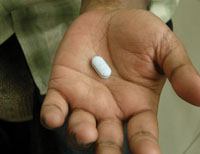23.3 The goal of adherence to ART
From a clinical point of view, patients need to achieve optimal adherence to ART to maintain an efficient level of drugs in their bodies. The measurable goal of adherence for your patients in the community or at the health post should be 100%. Poor adherence (adherence below 100%) leads to drug resistance, increased viral load, increased sickness, and increased possibility of death. Therefore, your activity in the community consisting of follow-up visits to patients on ART or other treatments contributes significantly to the general adherence status of your patients.
Optimal means ‘the most effective’.
How do you assess the adherence status of a person living with HIV on ART? Adherence is a measurable pattern of behaviour. For example, you can calculate the percentage of tablets taken correctly in a month by dividing the total taken by the total number that should be taken. Then you multiply that number by 100 to obtain the percentage adherence of an individual on ART. Optimal adherence is 100%, which means that a patient should take all of their drugs correctly without missing any one at any single time (Figure 23.2).

Calculate the monthly percentage adherence of a patient who missed six tablets out of the total he should be taking in a 30-day month. He should take two tablets every day.
This patient takes two tablets every day, so he should take a total of 60 tablets in one month. However he missed six tablets in one month. So his monthly adherence is 54 tablets out of 60. So, by dividing 54 by 60 and multiplying the result by 100, his percentage adherence can be calculated as 90% (54/60 = 0.9 × 100 = 90).
23.2 What is non-adherence?
